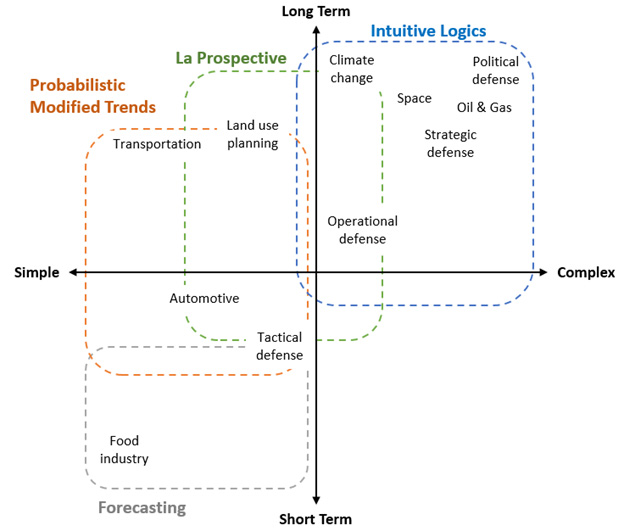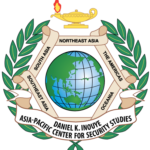Strategic foresight
The world is constantly evolving and changing, which often results in significant impacts on society and the crisis management community. Staying ahead of the curve requires not only an understanding of systems and complexity, but also creative and collaborative thinking and action. Strategic foresight is an ancient and latent human capability. As for all innate talents, some people are better at it than others are, and training in structures, models and methods can make a big difference.
Royal Dutch Shell is most often cited as an example of early foresight methodology development. Since the 1970s, they have explored alternative scenarios of the future to help leaders make better decisions, understanding possibilities, and characterize uncertainties. Participants in the scenario-planning process expand their thinking, consider “what if?” questions and reflect on remotely possible events (Shell 2018). However, this approach was not new and had its origin in military experience, for in 1965, the U.S. Secretary of Defense McNamara stated that military decision making was becoming more dependent on exploring future scenarios, such as potential conflicts, political constraints, physical conditions and alternative force sizes in relation to emerging tasks and their contingencies (Brown 1968). At that time, approaches to gaining insight into possible future scenarios were written essays, manual wargames or even abstracted data processed by computer models.
Proactive emergency management agencies have recognized the need to reflect on the challenges that will come with future crises and some, such as the US Federal Emergency Management Agency (FEMA), have conducted strategic foresight activities (FEMA 2012 a,b). FEMA seeks to “understand how the world around us is changing, and how those changes may affect the future of emergency management.” They engaged the diverse emergency management community in a collective exploration of issues, trends, and other factors that could impact the future environment, and to support expanded strategic thinking and planning for the future.
Strategic foresight encompasses various methods, processes and tools that assist decision makers to make sense of their complex problems with a view to guiding future-orientated decisions and planning (Vecchiato and Roveda 2010, Vecchiato 2012). Foresight is an umbrella term for methods that intend to provide insight into plausible future situations. It does not concern predictions or forecasting the future. This can be of benefit to strategic planning, policy formulation and solution design methods that work with alternative futures. It is not useful for crisis managers hoping for a crystal ball to predict the next crisis (Constantinides 2013). Foresight is a systematic, participatory, reflection and non-short term process that enables decisions, aligns stakeholders to take joint action, and assists in forming vision (Miles et al 2016). It empowers decision makers and policy planners to use new ways of thinking about, talking about, and implementing strategic plans that are compatible with the unfolding future (UNDP 2018).
Scenario planning
Since the military development of scenarios as a planning tool, many other approaches have followed, which has led to some confusion as to how it is used and where it is best applied.
Foresight tools, such as scenario planning, facilitate future-orientated awareness that works by overcoming pre-existing biases, simplifying complexity, and reducing uncertainty with the aim of fostering faster and more effective decisions (Bootz 2010, Ringland 2010). Scenario planning has been used in corporate decision making processes since the late 1970’s and has been found to help make sense of uncertain environments, overcome their cognitive limitations and improve mental agility (Vecchiato 2012). Scenario planning brings together decision makers with key stakeholders who generate insights through a workshop type process as they explore the development of alternative futures (Horton 1999).
Bradfield et al (2005) recommended the application of scenario planning in the following areas:
- Simulations of future crisis situations to improve crisis management
- Increasing the degree of complexity of scientific models and theory
- Involving multiple agencies and stakeholders in policy decisions
- Spreading ideas on critical trends that will shape the future
- Creating more complex learning environments
- Long range planning
Military planners even used the method in World War II to develop a series of alternatives futures in an attempt to make sense of potential enemy actions (Bradfield et al 2005). Brown (1968) recommended four levels of decision making in the field of national security:
- Efficient management of operations
- Choice of tactical alternatives
- Systems engineering, design and research – e.g. finding better measures for evaluating the performance of alternative systems
- Determining major policy alternatives – e.g. analysis of alternative means for implementing basic strategies; analysis of the impact of force posture; strategic alternatives on ability to achieve foreign policy objectives
Cognitive psychology proposes that humans possess codified knowledge based on processed information, and tacit knowledge based on unprocessed information (van der Heijden 1997, Brockmann and Anthony 2002). Codified knowledge has meaning while tacit knowledge has not had any meaning ascribed. Once tacit knowledge is encoded, cognitive bias breaks down and it becomes easier to understanding novel complex problems.
Scenario planning is a process used by organizations that wish to evaluate their readiness for the future by developing and examining the implications of a range of possible alternative futures. Scenarios are extrapolated from a detailed systematic analysis of the driving forces of change that an organization may face over the next 15 to 30 years. Strategic planning decisions are strengthened by going through the process of envisioning how current strategies and operating models would perform under different future scenarios. Crisis managers have found scenario planning a useful tool for managing uncertainty, risk, and opportunity because it provides a well-tested framework for understanding future needs and prioritizing near-term actions.
Scenario planning is a tool that places participants in a tacit knowledge environment, outside their present frame of reference, and requires them to create codified knowledge as they struggle to make sense of a new environment. This exercise enhances a person’s ability to anticipate by overcoming cognitive biases and moving the new situational knowledge from tacit to codified (Bootz 2010). The process of challenging assumptions, frames of reference and knowledge sources further helps to overcome many natural cognitive limitations in decision makers.
The selection and application of different scenario planning processes depends on the main characteristics of an organization’s business environment and on available expertise. Cardoso and Emes (2014) presented a framework that capture this selection process (Figure 1).
An intersection of the extremes of time and complexity creates the framework that guides strategy selection. Time refers to the timescale of key processes. Short-term endeavors may rely on forecasting, whereas foresight is more suitable for mid to long-duration projects. Complexity refers to how easy or difficult it is to understand the relationships between an issue’s driving forces and uncertainties. Issues with clear, visible cause-and-effect relationships are designated simple or low complexity, while high complexity issues are those in which the cause-and-effect between driving forces and uncertainties are not fully visible or well understood or known.
Based on this approach, the most suitable techniques for operational, strategic and political defense fall under the category of Intuitive Logics. The Forecasting, Probabilistic Modified Trends and La Prospective approaches are mainly quantitative, analytical and probabilistic in nature. This renders them more suitable for clear risks and less appropriate for low probability, complex risks.
The previously mentioned Royal Dutch/Shell method is an excellent example of Intuitive Logics. This group of techniques is characterized by its subjective and qualitative nature and relies on disciplined intuition, brainstorming, stakeholder analysis and STEEPLES (Social and cultural, Technology and science, Economic, Environment, Political, Legislative, Ethical and Security) analyses to understand the driving forces of change and how the issue of interest may evolve.
 Figure 1: Framework for selection of scenario planning processes (Modified from Cardoso and Emes 2014).
Figure 1: Framework for selection of scenario planning processes (Modified from Cardoso and Emes 2014).
Key aspects of the Intuitive Logics approach as derived from Huss and Honton (1987), Schwartz (1996), Bradfield et al (2005), and Garvin and Levesque (2006):
- Identify the focal issue or decision to be analyzed
- List all the driving forces that affect the focal issue
- Separate the driving forces into predetermined, whose evolution can be reasonably predicted, and uncertain
- Rank the uncertain driving forces with respect to their impact on the focal issue, and identify their value range (e.g. extreme values)
- Create the scenario space by selecting the two most important uncertain driving forces – the critical uncertainties – using their value range as the axes of a two-dimensional graph
- Develop the scenarios based on the critical disruptive uncertainties and plot them on the scenario space (scenarios are usually characterized by a pair of extreme values of the critical uncertainties)
- Develop narratives describing the evolution of the world from its present state into that described by each of the scenarios, while considering the evolution of all the driving forces
- Assess the implications of each scenario for the focal issue
- Identify, for each scenario, early warning signals
Alternative scenarios of equally likely, plausible futures are developed using this theme-based approach. Each scenario is accompanied by a description of the end-state, an explanation of how the driving forces affected the primary parameters to result in the end-state, and a narrative description.
Scenario planning enhances strategic agility, which is the ability to have flexible, mindful responses to a constantly changing environment (Lewis et al 2014). Leaders are faced with an increasingly complex and changing environment that often renders decisions ineffective (Chermack, 2004). Mastery of this method assists executives to sustain organizations in complex systems partly because leaders are more capable of managing paradoxes within themselves, their teams and the wider organization.
A strategic option
When FEMA began its foresight study, it sought to prepare the emergency management community for future unknown challenges, create a shared sense of direction, instill a sense of urgency, and drive action toward meeting shared future needs. FEMA recognized that knowledge of future trends and drivers could be actively used to promote foresight approaches to decision making. This led them to identify and support applications of foresight, and provide information and tools to promote the use of foresight across the whole community to improve resilience (FEMA 2010 c).
The foresight approach to strategic thinking and planning is very different from traditional planning methods, which tend to focus on the short term when uncertainty is lower. Traditional methods increasingly fail as uncertainty increases, which is when foresight becomes useful. Rather than predicting the future or forecasting of future trends and conditions, and creating a master plan, the intent is to explore what the future might look like and determine preliminary actions that are likely to be effective in any future (FEMA 2012a).
One criticism of scenario methods is that they may lack political credibility. Brown (1968) thus cautioned scenario users against approaching scenario methods in a casual manner and recommended the involvement of subject matter experts, who likely have strong and different opinions when it comes to matters of national security. Experts can at least defend why certain controversial elements are included in a scenario. In that regard, nothing has changed. Whether scenarios are used in wargames or as alternative plausible futures, they should never be viewed as a tool for problem solving, for they are only method by which to simplify complexity and gain strategic insight into a wicked problem.
References
Bootz J. Strategic foresight and organisational learning: A survey and critical analysis. Technological Forecasting & Social Change 2010;77:1588-1594.
Bradfield R, Wright G, Burt G, Cairns G, van der Heijden K. The origins and evolution of scenario techniques in long range business planning. Futures 2005;37(8):795–812, doi:10.1016/j.futures.2005.01.003.
Brockmann EN, Anthony WP. Tacit knowledge and strategic decision making. Group & Organization Management 2002;27(4):436-455.
Brown S. Scenarios in systems analysis in: E.S. Quade, W.I. Boucher (Eds.), Systems analysis and policy planning: applications in defence, American Elsevier Publishing Co., New York, 1968.
Cardoso JF, Emes MR. The use and value of scenario planning. Modern Management Science & Engineering 2014;2(1):19-42.
Chermack TJ. Improving decision-making with scenario planning. Futures 2004;36:295- 309.
Constantinides P. The failure of foresight in crisis management: A secondary analysis of the Mari disaster. Technological Forecasting and Social Change 2013;80(9):1657-1673. https://doi.org/10.1016/j.techfore.2012.10.017.
FEMA. Crisis response and disaster resilience 2030: forging strategic action in an age of uncertainty. Strategic Foresight Initiative, Federal Emergency Management Agency 2012a.
FEMA. Foresight workshop how-to-guide. Strategic Foresight Initiative, Federal Emergency Management Agency 2012b.
FEMA. Foresight workshop how-to-guide. Strategic Foresight Initiative, Federal Emergency Management Agency 2012b.
Garvin DA, Levesque LC. A note on scenario planning. Harvard Business School 2006;306(003):1-10.
Horton A. A simple guide to successful foresight. Foresight 1999;1(1):5-9.
Huss W, Honton E. Scenario planning – What style should you use? Long Range Planning 1987;20(4):21-29.
Lewis MW, Andriopoulos C, Smith WK. Paradoxical leadership to enable strategic agility. California Management Review 2014;56(3):58-77.
Miles I, Saritas O, Solokov A. Foresight for science, technology and innovation. Springer Switzerland 2016.
Schwartz P. The art of the long view: planning for the future in an uncertain world. New York, NY: Doubleday, 1996.
Shell. What are Shell scenarios? https://www.shell.com/energy-and-innovation/the-energy-future/scenarios/what-are-scenarios.html (accessed Nov 2018).
UNDP. Foresight manual: empowered futures for the 2030 agenda. Global Centre for Public Service Excellence, Singapore.
Van der Heijden K. Scenarios, strategies and the strategy process. Nijenrode Research Paper Series, Centre for Organisational Learning and Change, 1997;1997-01.
Vecchiato R, Roveda C. Strategic foresight in corporate organizations: Handling the effect and response uncertainty of technology and social drivers of change. Technological Forecasting & Social Change 2010;77:1527-1539.
Vecchiato R. Environmental uncertainty, foresight and strategic decision making: An integrated study. Technological Forecasting & Social Change 2012;79:436-447.
Published: January 7, 2021
Category: Perspectives
Volume: 22 - 2021
Author: Deon Canyon






2 Comments